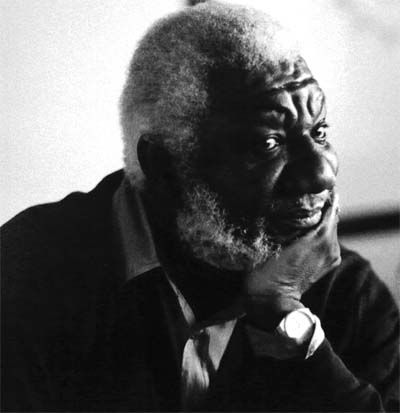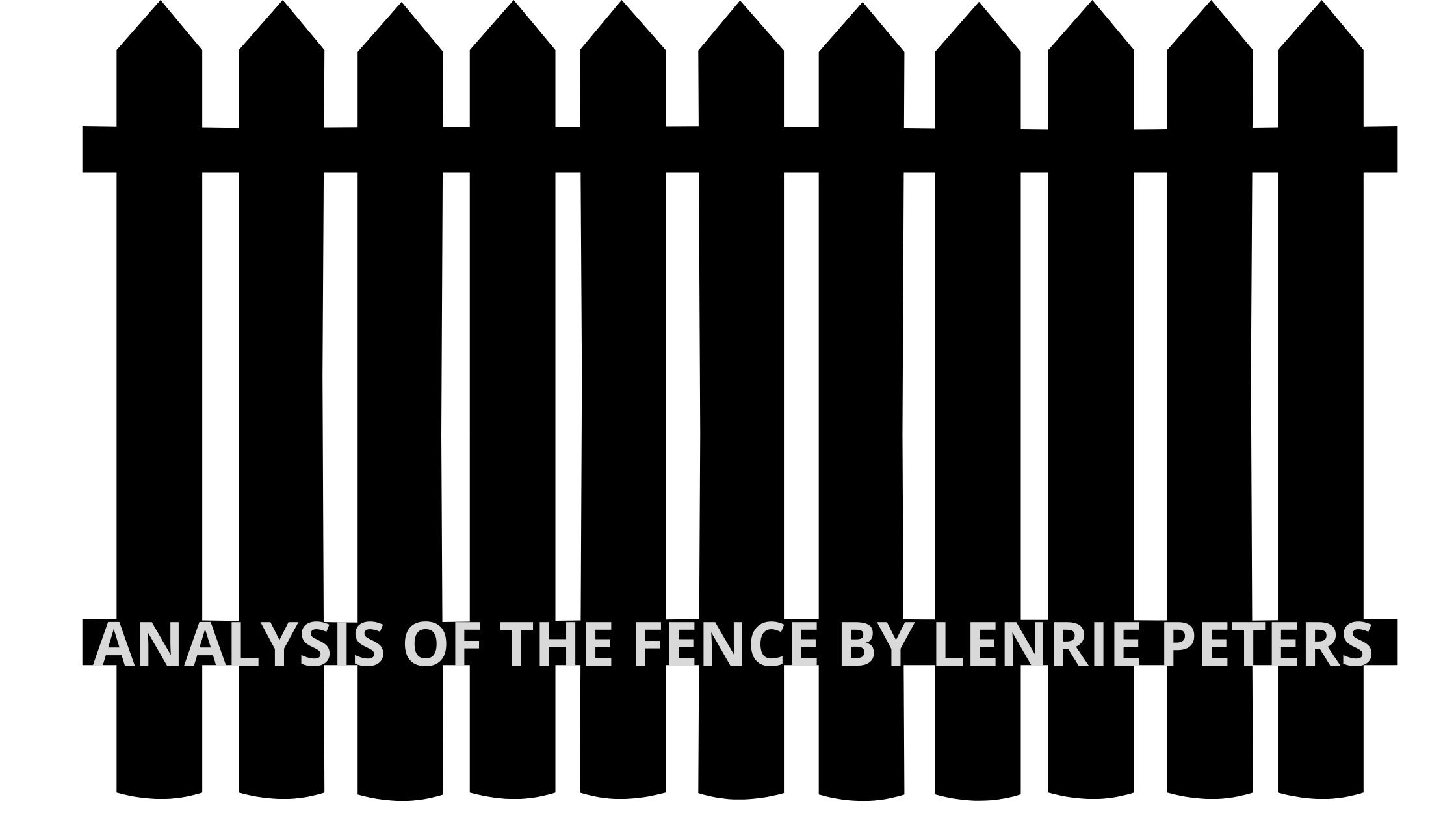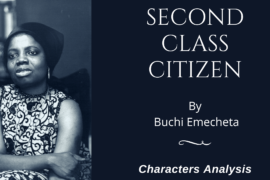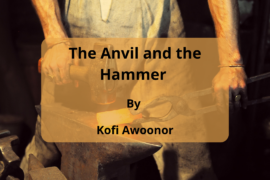In this article, we will be discussing the analysis of the fence by Lenrie Peters which includes; the background of the poem, the subject matter, the summary, the setting, the themes, the figurative devices, the structure, frequently asked questions, and the biography of Lenrie Peters the poet.
Read The Fence By Lenrie Peters HERE
Analysis of The Fence by Lenrie Peters
Background
Moral and philosophical issues have always been with a man in all climes and everywhere. However, Lenrie Peters has been reported to be continually troubled by the tendency of those who matter in the effort to lift up the downtrodden, the oppressed, and the dispossessed, to flinch from this naturally imposed responsibility.
He said to be even more troubled by those who are neither here nor there. His view is that you cannot sit on the fence in a struggle and still say are on the side of the masses. This disposition towards justice, freedom from oppression, and general attitude to life provides the background to this poem.
Subject Matter/Summary
The poem reflects on the challenge of irresolution which is often the lot of most people when it comes to doing what is good. In this regard, it focuses on two points.
First, it focuses on choosing between doing what is good or the right thing and doing what is bad or the wrong thing.
Secondly, it focuses on knowing what is right and doing it. Finally, it captures the mental and moral struggles between these divides.
Setting
The poem is set in the post-Independence Gambia. At this time, the gap between the rich and the masses kept increasing and nobody seemed to be interested in a lot of the downtrodden Gambians. However, as a poem that engages moral issues from a philosophical perspective, the setting can also be said to be universal. The moral and philosophical issues have always been with a man in all climes and everywhere.
Line1-3
These lines express the person’s indecision over whether he should look back to the dark past or content himself with hope in the uncertain future.
Line 4-6
In these lines, the persona intimates us of his vacillation between telling the truth and telling lies. There is a suggestion that the persona finds this a very excruciating experience.
Lines 7-9
These lines corroborate the persona’s earlier irresolution as he dithers to and fro in what seems a perpetual order. Specifically, they refocus attention on the persona’s vacillation between reaching for the past and reaching for the future.
Lines 10-12
These lines show the persona’s as identifying with the twilight of man’s life; that advanced stage of growth where the body becomes weak. He wonders at his observations.
Lines 13-19
In these lines, the contradictory forces of good and bad get ranged against the persona and torture his mind.
He tries to concentrate his efforts on reaching a decision by coming up with different strategies to stop the persistent struggle between the two forces, but to no avail. His head begins to spin like that of a drunkard and staggers.
Lines 20-22
In these lines, the persona realizes that he is the one who has taken on a wrong perception of the world because of his refusal to cross the fence. He has chosen to remain undecided.
Lines 23-25
Apparently having got over an aspect of his decision, the persona is still trapped between knowing the need for what is good and actually carrying it out.
Read The Fence By Lenrie Peters HERE
Themes
a) Problem of Dilemma
The dominant theme in the poem is the problem of dilemma. Through the persona, we are presented with a problem most human beings get confronted with from time to time. A lot of people find it difficult to let go of the past, especially an ugly one, and tend to be cynical about the future. Because of this, they are neither here nor there.
They don’t identify with a value belonging to either and hold onto it. With regards to truth and lies, the persona is also caught between two divides. He does not tell the truth. Yet he is not ready to tell a lie. He, therefore, struggles in between.
This problem of irresolution is explored further, ‘where times moves forward and backward’ and the persona is unable to seize one moment for his own profitable engagement. The result is that he finds himself ultimately at ‘the stage where the body ages relentlessly and only the feeble mind can wander back’.
b) Pain and Suffering
This theme is explored as a consequence of irresolution or dilemma. As a result of sitting on the fence, the persona is depicted as undergoing serious mental agony and emotional turmoil. We are informed that when ‘all the opposite arrive’, they ‘plague the inner sense’ of the persona.
The result is that he is physically and mentally discomfited. His head begins to spin, and he staggers from the feeling of dizziness. Because he has lost his mental discernment, the world seems to have changed. Sadly, by the time he realizes the contrary, he is still trapped between knowing ‘the need for good’ and ‘the doing good’.
Language and Style
Towards effective meaning delivery, the poet uses a number of poetic devices, which includes the ones discussed below
Refrain
The expression,’ there I lie’, is used as a refrain in the poem. Except for the sixth stanza, the expression is used exactly like this or slightly modified in all other stanzas of the poem. The consequence is that it gives some lyricism to the poem.
The placement of this refrain in the poem is also significant. It is placed at the centre where it constitutes the last lines of five of the stanzas. By placement, the persona’s choice of sitting on the fence is underscored.
Repetition
Similarly, some other expressions are used repeatedly in the poem. For instance, ‘there were’ is used six times, with each use beginning a new stanza apart from the sixth one. Unlike the other cases of repetition in the poem, its use is also anaphoric since it occurs at the beginning of each line we find it. The other case of repetition is found in line 17 where the poet talks of his head going ’round and round’.
This repeated description of his head movement demonstrates the severity of the dizziness he experiences and by implication, the physical and mental agony he goes through. The expression ‘there where’ is also meant to underscore the self-imposed immobility of the persona from the fence on which he sits. Both repetitions also contribute significantly to the musical enrichment of the poem, in addition to their emphatic significance.
Irony
There are two instances of ironic construction in the poem. In line 11, the poet asks for a ‘feeble mind’. This is ironic in the proper context of the poem where the poet writes, ‘there where the body ages relentlessly/ and only the feeble can wander back’. It is certainly a sharp mind that is capable of remembering the past, not a weak one as suggested here. In another instance, the persona says, ‘I feel the buoyant waves; I stagger’. Here, the word buoyant, rather than implying gaiety or liveliness, actually refers to the light-headed dizziness that results from mental agony.
Personification
The device is used in line 20 where the persona observes that ‘it seems the world has changed her garment’. Here, the word is portrayed as a lady who has changed her dress. This shows that the poet treats the world as having human qualities.
Metaphor
Relying on the conceptual theory which views metaphor as the use of knowledge of one domain to generate meaning in another, the poet’s description of the struggle between truth and untruth as a ‘bloody combat’ is metaphorical. The struggle is indirectly compared to what obtains between two soldiers of different enemy forces, which results in bloodshed.
Imagery
Imagery is means the use of words to evoke mental pictures in the reader. Particularly in the sixth stanza, a number of images are generated through the effective choice of words. The arrival of opposites ‘to plague the inner sense of the persona brings a picture of terrible affliction, reminiscent of the biblical plague.
Such expressions as ‘I hold my head’, ‘my head goes round and round’ and ‘stagger’ call up images of a man that is destabilized, troubled and agonized. We also see the picture of a man struggling with the force of evil and good.
Structure
The poems consist of twenty-five lines in seven irregular stanzas. Six of these stanzas comprise three lines each. The sixth stanza which is the longest comprises seven lines. In the first three stanzas, each of which is a quasi-triplet because the three-line making each up do not rhyme, the poet uses a structure of opposites in getting his ideas across.
The first stanza juxtaposes the issue of the past and future; the second one, truth, and untruth while the third one talks about ‘forwards and backwards’ The physical arrangement of the verse of the first three and the last two stanzas is such that the lines gradually narrow down from the first to the last line, resulting in a situation whereby each of the stanzas forms a V-shape. The refrain at the base which is ‘there I lie’ is therefore central to demonstrating the poet’s continued sitting on the fence.
Frequently Asked Questions
Critically examine the view that ‘the fence’ is about the struggle between good and evil.
Answer
Everything in creation has two sides to it, be it good or bad, positive or negative. This shows that God or nature established this order. Therefore, as the existence of the other, so does the identification with one presuppose the rejection of the other. In a nutshell, taking the middle course is not favoured. In this poem, however, the poet-persona chooses the middle course as he struggles between the good and the bad.
In the first stanza of the poem, we encounter the persona vacillating between sticking to the past and embracing the future. Here we are informed that the past is “dim”, which suggests that it is dark or ugly. By this depiction, the past in this context is presented as unpleasant. The future is always generally believed to hold a better stock, no matter how bad or even good the past has been. On this assumption, the future is treated as being more desirable. Everyone looks forward to it. In this poem, however, the poet is not enchanted by the future, yet, he is not going for the past. He is found struggling between the two and what they represent.
In the second stanza, of the poem, the struggle is between ‘ truth and untruth’.Unlike what we have in the previous stanza, these are obviously good and bad issues. According to the poet, the struggle between good and evil forces is a fierce one as it is a ‘ bloody combat’. Not only this, the struggle is described as an ‘ endless’ one. In spite of the bloody and eternal nature of this struggle, the persona still finds himself in a moral dilemma over which side to switch.
As a result of this struggle and the persona’s misplaced belief in maintaining the middle course, more evil is allowed to happen. We note that as ‘ the opposite arrives’ more havoc is wreaked because both sides of the divide, ‘do not fuse’. Rather than come together, despite the effort ‘ to stop the constant motion’, they go their separate ways and cause the persona’s head to spin, making him dizzy and stagger as if we were drunk.
In the last stanza of the poem, the persona turns to evil and good inherent in knowing what is good and refusing to do it. Here, the struggle is not between evil and good as we know them. It is about identifying the berry to do good and actually doing it. As the persona is, again, unable to will himself to do good when he sees one, the poet takes us back to the struggle between good and evil forces. This is because realizing the need to do what is good and choosing not to do it is tantamount to doing evil. This is totally opposed to doing what is good.
From the foregoing, we can see that the idea of sitting on the fence which is often characteristic of people when they are required to stand by the disadvantaged brings about dire consequences on the individual concerned in the long run. As the poem shows, the struggle between good and evil will be perpetual as long as we choose to sit on the fence.
Biography Of Lenrie Peters.

Born in 1932, Peters had his early education in Gambia and later proceeded to Trinity College, Cambridge, and University college hospital, London where he got a BA and MD degrees respectively. After working briefly in England, he returned to Gambia in 1969 to take up employment with the government hospital as a surgeon.
Later, he co-founded the first private clinic in his country, Westfield clinic, with Dr. Samuel J.Peters. Peters started his writing career as a student at Cambridge where he wrote poetry and plays. His first and only novel, the second round, was also started while at Cambridge. His published works include poems (1964), The Second Round (1965), satellite (1967), katchikali(1971), and selected poetry (1981). As a pan-Africanist, his works are largely concerned with African themes just as his medical background also influenced his work. He died in 2009.
We have already discussed the analysis of The Fence by Lenrie Peters which consists of the background of the poem, the subject matter/summary, line by line analysis, themes, language and style, figurative devices, question and answers, structure and a brief biography of the poet.



